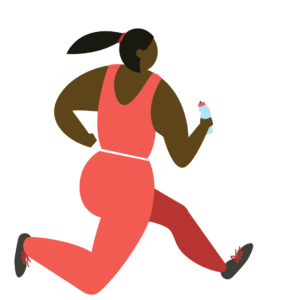When 30,000 other sweaty runners are tossing their cups, odds are more than likely that you’ll toss your cup, too. We’re normative creatures. We look to others to see how things are done. But when we stop (wait, don’t stop, you’re on track for a PB!) and think about it, we realize how unsustainable some of our race behaviour really is.
Races are about striving to be our best. When all your energy is focussed on speed, it can be hard to make time for thoughts on how to reduce the waste. But in our interviews with race directors and runners, we realized there’s greater aptitude for making our sport sustainable than you might think. Runners want to be green, but it’s up to races to make being green an easy and logical choice.
Do you need that shirt or medal?
“For people who do a bunch of races, it’s not a thing,” says Charlotte Brookes, Event Director at Canada Running Series. “For your first half and first 10K, it’s really important. Some shirts are important, and others are not seen as valuable.”
Increasingly, races are contemplating the option to opt-out of medals and shirts. But runners sometimes expect greater discounts for doing so, which can be tricky. “People say I don’t want a T-shirt and I want a $20 discount,” says Scotiabank Calgary Marathon Executive Director Kirsten-Ellen Fleming. “That’s not realistic, so all of us—race directors and runners—are still trying to figure out the new math.”
The medals, shirts, water bottles and cups are low-hanging fruit, but course-level stuff is harder to course correct. One good option is pilot tests in smaller races. “This September, we have a race with the zoo and we’re going to take that cupless,” says Fleming. “We’ll start there and see what kind of feedback we get.”

Sustainability = Inclusivity
As races creep up in price, sustainability also has the added bonus of fostering inclusivity.
Our number one goal is making sure our races are inclusive, says Caitlin Brown, outreach coordinator at Mountain Equipment Co-op. “Maybe you can’t afford to pay,” she says. “We try to eliminate that through pricing. One way to achieve that is through no frills. We’re not having those additional supplies that sit in someone’s drawer at the end of the day.”
Sponsors are on board
Increasingly, sponsors are making sure their offerings are as sustainable as possible, whether this means using compostable cups, or not giving away stuff at all. Virtual race kits offer concrete data, and a chance to optimize ads and offers to make sure they’re working. “People are definitely on board. The stats and click-through is very valuable,” says Brookes.
It’s also a great learning opportunity for everyone. Often a sponsor might not have thought about a particular sustainability issue. “Jugo Juice is one of our sponsors and when we asked them to source compostable cups, they were happy to do so,” says Calgary’s Fleming. “I think sustainability is something that everyone wants to see.”
This is our sport
A final consideration is the slightly biased idea that runners are awesome. We’re generally low-maintenance people, who love to explore the earth under our feet. Our sport takes place largely outside, and we are witness to the effects climate change is having on our stomping grounds. So it’s no surprise that runners are open to sustainable sport.
It’s a luxury to be able to train for hours a week, and to participate in races all over the globe in the name of racing and running. The challenge of making running zero-waste is a daunting one, but we face daunting challenges every time we get on the line.
To get your thoughts on sustainability and racing, please see our survey online. In addition, you can leave your survey wherever you picked up your copy of iRun to make your voice heard. Illustrations by Zhen Li.







